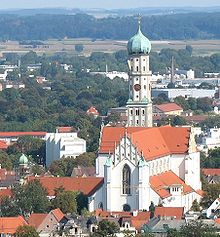A request that this article title be changed to Abbey of Saints Ulrich and Afra is under discussion . Please do not move this article until the discussion is closed. |
Imperial Abbey of Saints Ulrich and Afra, Augsburg Reichskloster Sankt Ulrich und Afra in Augsburg | |||||||||||
|---|---|---|---|---|---|---|---|---|---|---|---|
| 1577a / 1643b – 1802 | |||||||||||
 The abbey of St. Ulrich and Afra in 1627 | |||||||||||
| Status | Imperial Abbey | ||||||||||
| Capital | St Ulrich's and St Afra's Abbey | ||||||||||
| Government | Elective principality | ||||||||||
| Historical era | Middle Ages | ||||||||||
• Founded | ca 10th century | ||||||||||
• Gained immediacy | 1577 | ||||||||||
1643/44 | |||||||||||
| 1802 | |||||||||||
| 1806 | |||||||||||
| |||||||||||
| Today part of | Germany | ||||||||||



St. Ulrich's and St. Afra's Abbey, Augsburg (German : Kloster Sankt Ulrich und Afra Augsburg) is a former Benedictine abbey dedicated to Saint Ulrich and Saint Afra in the south of the old city in Augsburg, Bavaria.
Contents
- History
- Imperial Abbey
- Abbots of St. Ulrich's and St. Afra's Abbey
- Burials
- See also
- References
- Bibliography
- External links
From the late 16th century onward, the Abbey of St. Ulrich and St Afra was one of the 40-odd self-ruling imperial abbeys of the Holy Roman Empire and, as such, was a virtually independent state. The territory of that state was very fragmented: the abbey of St. Ulrich and St Afra proper enclaved within the Free Imperial City of Augsburg, and several small territories disseminated throughout the region. At the time of its dissolution in 1802, the Imperial Abbey covered 112 square kilometers and had about 5,000 subjects. [1]

